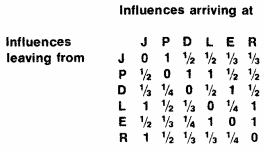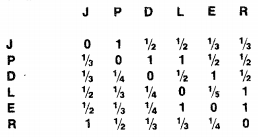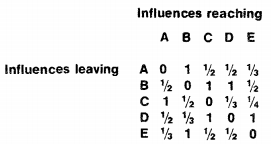Adapted from a French version, and applied to networks, by A.J.N. Judge.
| How to work in a group without being a leader and without being a slave (see first text below each image, in roman type). | How a group can work with other groups in a network, without coordinating them all and without being their slave (see second text below each image, in itallic type). |
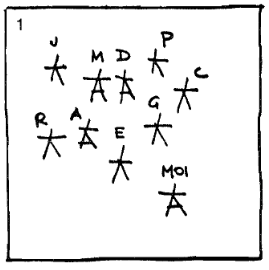 |
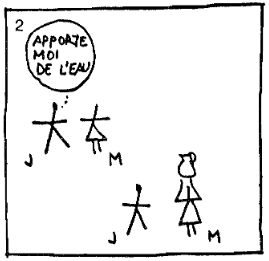 |
 |
|||
| We form a group: John, Mary, Peter, Denise. Guy, Roger, Anne, Edgar and me. | If John asks Mary to do something, she does it. | If Mary asks John something, he ignores her. But if Edgar asks him, John runs to do what Edgar requested. |
|||
| The groups: J, M, P, D, G, R, A, E and MD.!. together form an organization network. | If the J-group asks the M-group to do something, it does it. | If the M-group asks the J-group to do something, the J-group does nothing. But if the E-group asks the J-group to do it, it does it immediately. |
|||
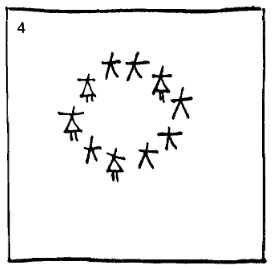 |
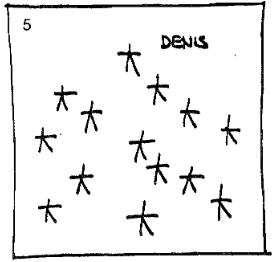 |
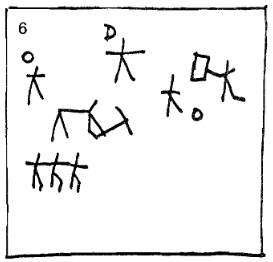 |
|||
| That is the way our group works. | I know of another group, to which Denis belongs. It is a group much larger than ours. In that group it is Denis who gives the orders. |
He gives various tasks to everyone and his officers (O) help him to supervise his group. He has as many officers as our group has members. |
|||
| That is the way our organization network works. | I know of another organization network to which the D.E.N.I.S. group belongs. It is an organization network much larger than ours. In that network it is the D.E.N.I.S. group which gives the orders. |
The D-group allocates tasks to every other group in the network and the coordinating sub-organs (O) of the D-group help it to control the network. The network has as many coordianting organs as our network has members. |
|||
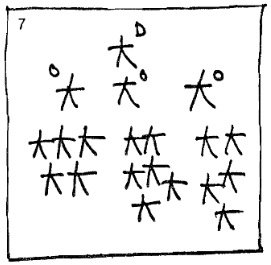 |
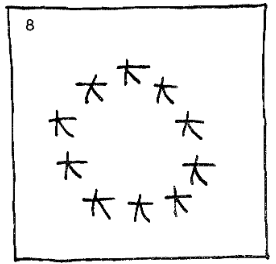 |
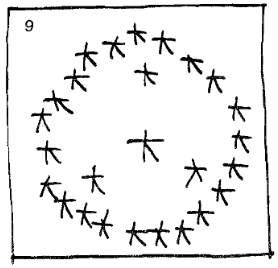 |
|||
| Denis gives orders to his officers, the officers give orders to the others, who, in their turn, are unable to give orders to anyone. That is the way Denis'group works. |
In our group, there is no leader. | In Denis'group, Denis is the leader. | |||
| The D-group gives instructions to the coordinating organs, the coordinating organs give orders to other groups, who, in their turn, are unable to give orders to anyone. That is the way the D-group's network works. |
In our organization network there is no leading group. | In the D-group's network, the D-group takes the lead. | |||
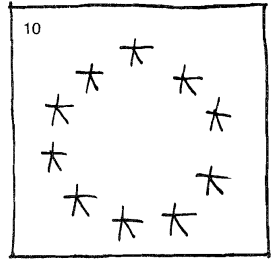 |
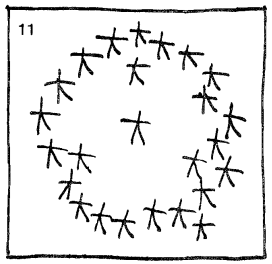 |
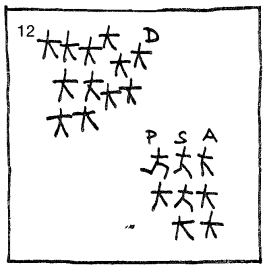 |
|||
| In our group there are few members. | There are many members in Denis' group. | Patrick, Sophie, Andrew and half-adozen of their friends left the Denis group. | |||
| In our organization network there are few member groups. | There are many members in the 0- group's network. | The P-group, S-group and A-group together with six other related groups left the D-group's network. | |||
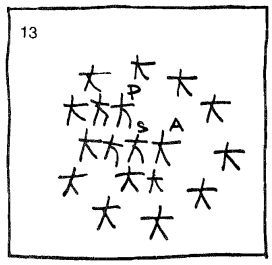 |
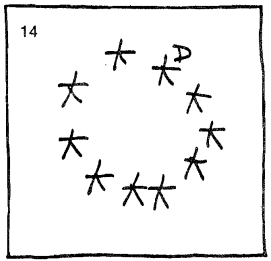 |
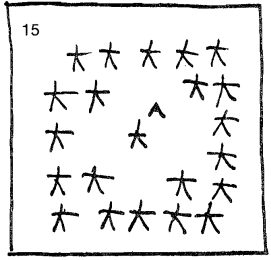 |
|||
| They joined our group. | Since then, Denis' group has changed: they no longer have a leader and Denis is no longer more important than the others. | However, our group now has a leader: Andrew. | |||
| They joined our organization network. | Since then, the D-group's network has changed: it no longer has a leading group and the D-group is no longer more important than the others. | However, our organization network now has a leader: the A-group. | |||
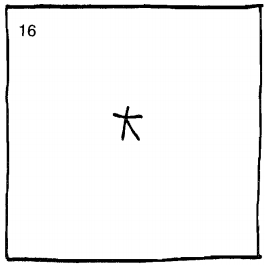 |
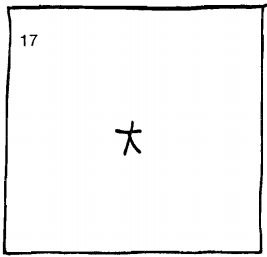 |
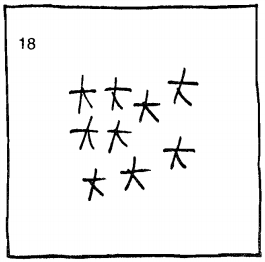 |
|||
| How can a group avoid having a leader? | How can one become a leader? | What will the others do in order not to have a leader? | |||
| How can an organization network avoid having a leading group? | How can a group become the leaa.f!r of a network? | What will other groups do in order not to have a leading group in the network? | |||
 |
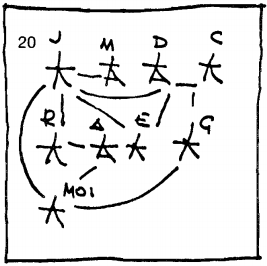 |
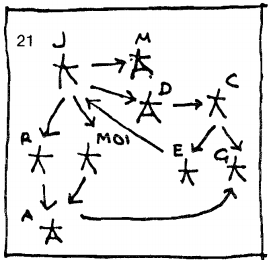 |
|||
| What will those who want a leader do to support him? | Let us take another look at our group. It consists of the individual group members linked together by a network of influences. | An influence has a direction which points towards the person who is influenced, namely to the person who « obeys» another. We can indicate such an influence by an arrow. | |||
| What will the groups which want a leading group do to support one? | Let us take another look at our organization network. It consists of the member groups linked together by a network of influences. |
An influence has a direction which points towards the group which is influenced, namely to the group which « obeys» another. We can indicate such an influence by an arrow. |
|||
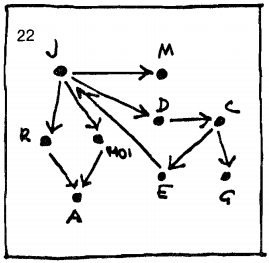 |
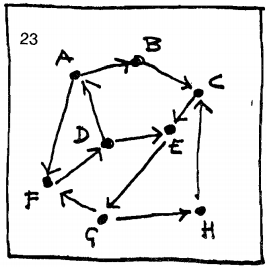 |
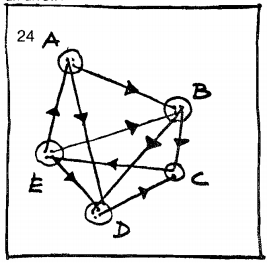 |
|||
| Each member of the group can be represented by a point labelled by name or some other sign. | In this way a diagram composed of: - points - arrows - labels is the « map" of a group. |
We could construct such a «group map " with the aid of: - pieces of string - paper arrows - buttons |
|||
| Each group member of the organization network can be represented by a point labelled by its name or some other sign. | In this way a diagram composed of: - points - arrows - labels is the «map» of an organization network. |
We could construct such an « organization network map » with the aid of: - pieces of string - paper arrows - buttons |
|||
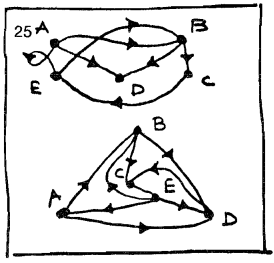 |
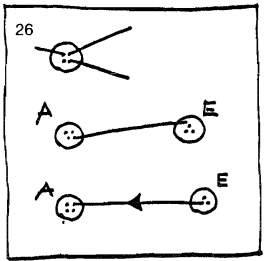 |
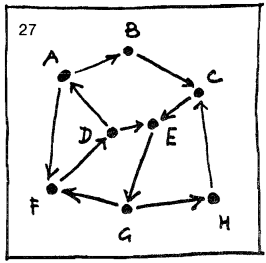 |
|||
| The shape of the « map » is not of interest to us. What is important is the « scheme of links » in the group. |
That is to say: - how many strings are linked to each button? - which two buttons are linked by the same string? - what directions to the paper arrows on each string point? |
How can we tell the" status» of someone in the group? Suppose we want to know about Antony (A). |
|||
| The shape of the {{ map» is not of interest to us. What is important is the "scheme of links» in the organization network. |
How can we tell the "status» of a group in the network? Suppose we want to know about the A-group. |
||||
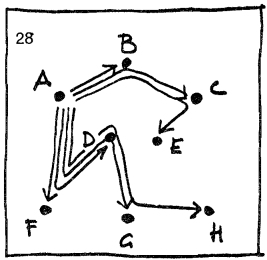 |
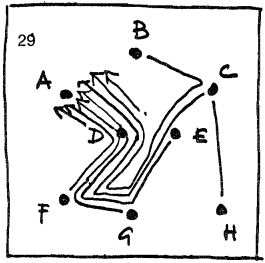 |
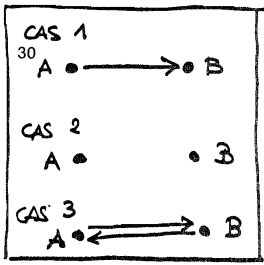 |
|||
| Well, Antony can influence all the others in the group, provided that Bernard, Charles, Fred, Daniel and George agree to transmit the influences from Antony, since only he has a direct influence on Bernard and Fred. | Antony may in his turn be influenced by everyone in his group provided that Daniel, Fred, George, Emil and Charles agree to transmit the influences. Only Daniel has a direct' influence on Antony. | Note: We recognize {{ influence» by the fact that the person influenced changes his habitual pattern of activity. e.g. A tells B to sit down. Case 1. B sits down Case 2. B does not sit down Case 3. B is prepared to sit down if A will also do so. |
|||
| Well, the A-group can influence all the others in the network, provided that the B-group, C-group, F-group, D-group and G-group agree to transmit the influences from the A-group, since only it has a direct influence on the B-group and the F-group. | The A-group may in its turn be influenced by every other group in the network provided that the D-group, F-group, G-group, E-group and C-group agree to transmit the influences. Only the D-group has a direct influence on the A-group. |
Note: We recognize «influence» by the fact that the group influenced changes its habitual pattern of activity. e.g. A-group instructs a-group to come to a meeting. Case 1. a-group comes to the meeting. Case 2. a-group does not. Case 3. a-group is prepared to come to the meeting if A-group will also do so. |
|||
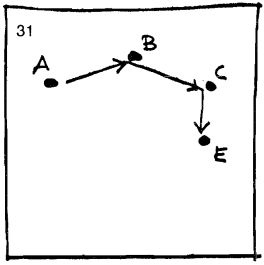 |
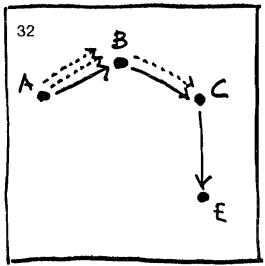 |
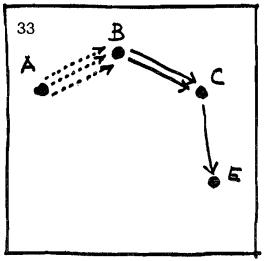 |
|||
| A large proportion of the influences can only reach someone in a group through others who act as intermediaries. Here, to influence Edgar, Antony says something to Bert, who transmits it to Charles, who in turn passes it on to Edgar. |
In transmitting the message from Antony to Charles, Bert slightly modified the meaning of it. | Charles, in passing on the message received from Bert (who received it from Antony), introduces a further modification. Edgar receives the modified message. | |||
| Here, to influence E-group, A-group communicates with a-group which contacts C-group, which, in turn communicates with E-group. | In transmitting the message from Agroup to C-group, a-group slightly modified the meaning of it. | C-group, in passing on the information received from a-group (which received it from A-group)," introduces a further modification. E-group receives the modified message. | |||
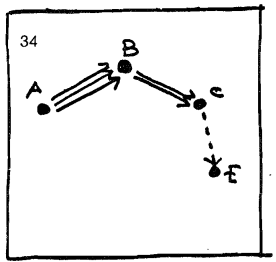 |
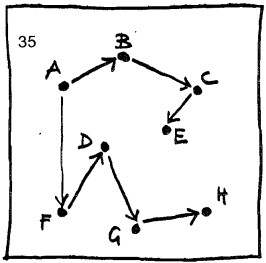 |
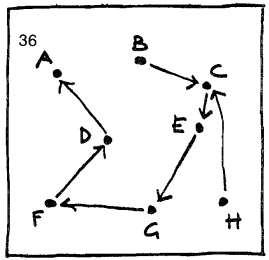 |
|||
| Each transmission of the message reduces the relationship to the original message. Here, 3 transmissions only let % of the original content through. |
Let us look at the influence of Albert on the others in his group (see bold text). | What about the influences to which Albert is exposed? (see bold text). | |||
| Let us look at the influence of A-group on the other groups in its network (see bold text). Direct influence on Band F |
What about the influences to which the A-group is subject in the network? (see bold text).C-group, in passing on the information received from a-group (which received it from A-group)," introduces a further modification. E-group receives the modified message. Direct influence from D |
||||
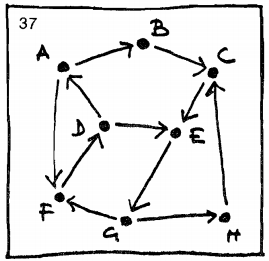 |
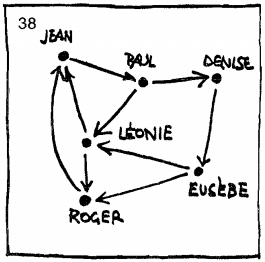 |
|
|||
| The « influence account" of Albert defines his "status" in the group (see bold text). The "influence account" of A-group defines its status in the group (see bold text) A exercises 31' / '2 influences. A receives 237/60 influences. A's « influence balance » shows that he exercises 1 ' %0 influences more than he receives. |
.png) |
||||
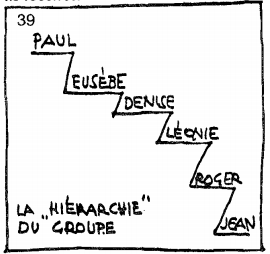 |
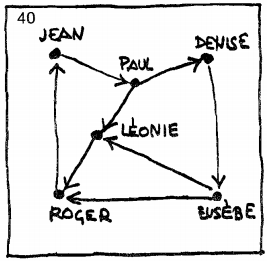 |
|
|||
| We can establish from the « influence balance » the hierarchical position of each person in Albert's group. We can establish from the « influence balance » the hierarchical position of each group in the A-group's network |
.png) |
||||
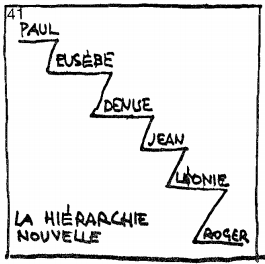 |
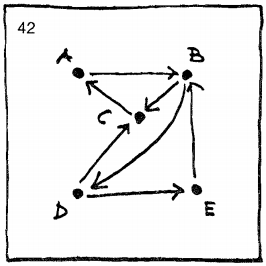 |
|
|||
| John (J) has in fact succeeded In changing his position, but also that of the others; simply by resisting Lionel (L) John has changed the structure of his group The J-group has, in fact succeeded in changing its position, but also that of the others, simply by resisting the L-group (L). The J-group has changed the structure of its network. |
.png) |
||||
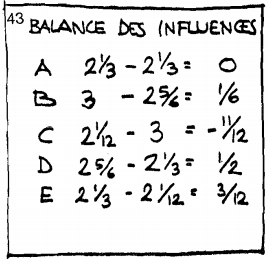 |
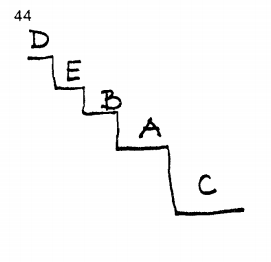 |
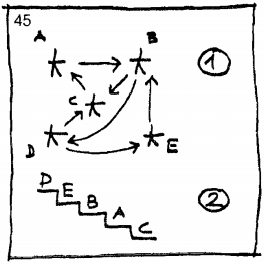 |
|||
| The influence balance is obtained by subtracting (for each member) the total number of influences received by the member from the total number of influences leaving the member. | The hierarchy of social positions can be produced by ordering the members in the decreasing order of their influence balance Here is the hierarchy of the example. It shows us the relative social positions of the members. |
The « map » of the member relationships (liaison scheme) shows the mathematical structure (1). The hierarchy of social situation shows us the social structure (2). The social structure depends upon the mathematical structure. |
|||
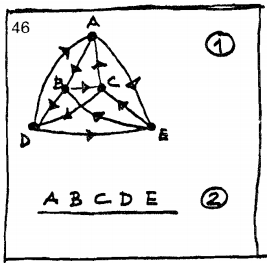 |
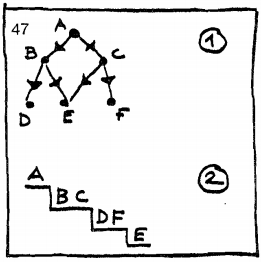 |
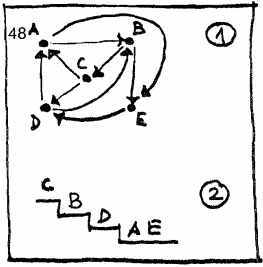 |
|||
| A group like this is an "egalitarian" group because the social situation of each person in the group is the same. | This group is « hierarchically » oriented. The social situation of the members goes from high to low. |
In this group the social positions are irregularly distributed. Most human groups are like this. |
|||
| A network of groups like this is an " egalitarian" network because the socia! situation of each group in the network is the same. | This network is « hierarchically » oriented. The social situation of the members goes from high to low. |
In this network the social positions are irregularly distributed. Most organization networks are like this. |
|||
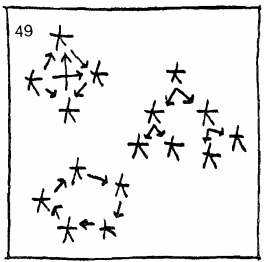 |
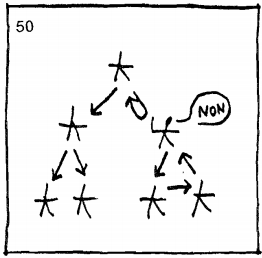 |
|
|||
| There are people who prefer egalitarian groups, others are at ease in hierachical groups, yet others try to belong to other types of groups. | |||||
| There are groups which prefer to participate in egalitarian networks, others, prefer hierarchically, coordinated networks, yet others try to belong to other types of network. | |||||
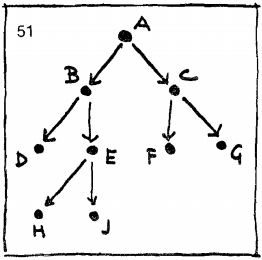 |
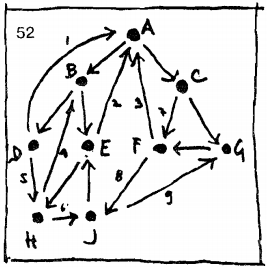 |
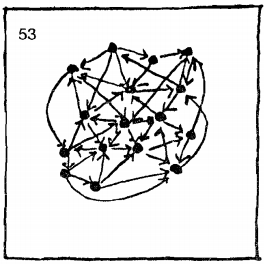 |
|||
| Here is a hierarchically oriented group. | This group may be transformed into an egalitarian group if everyone wills it so - certain influences are « eliminated » and others are « added ». The cooperation of the individuals, D,E,F, and G is all that is required. |
But be careful I Not all groups are viable. There are limits. For example there is the limit which we call « valency ». This shows how many influences an individual can receive or exercise in a group in a given period. | |||
| Here is a hierarchically oriented network. | The cooperation of the groups D, E, F, and G is a/l that is required. | But be careful! Not all organization networks are viable. There are limits. For example, there is the limit which we call « valency ». This shows how many influences a group can receive or exercise in a network in a given period. | |||
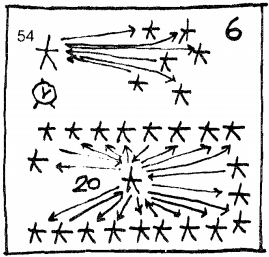 |
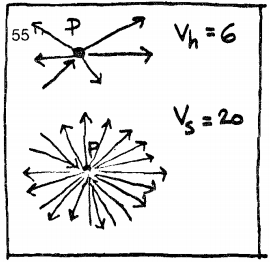 |
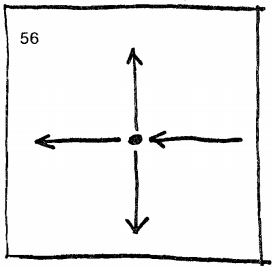 |
|||
| Peter can speak, discuss and influence 4 of his friends in 1 hour, but he cannot do it with 6. In one week, however, he could influence 20. | The « valency » of Peter is 6, if it is a question of the number of inter-personal decisions per hour. His valency is 20, if it is a question of the number of decisions per week. |
Different people have different « valencies », with respect to their groups. The simultaneous « valency » of a person (the number of other people with whom he can discuss at the same time) rarely exceeds 4. | |||
| The P-group can communicate with and influence 4 of the other groups in the network in 1 hour, but it cannot do so with 6. In one week, however, it could influence 20 groups. | The « valency » of the P-group is 6, if it is a question of the number of intergroup decisions taken per hour. Its valency is 20, if it is a question of the number of decisions per week. |
Different groups have different « valencies » with respect to their networks. The simultaneous « valency » of a group (the number of other groups with whom it can interact at the same time) rarely exceeds « ? » (we don't know). | |||
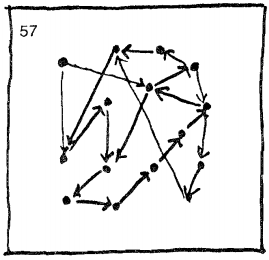 |
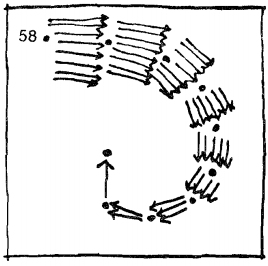 |
|
|||
| Another obstacle to the growth of a group is its « transmission capacity ». | |||||
| Another obstacle to the growth of an organization network is its « transmission capacity ». | |||||
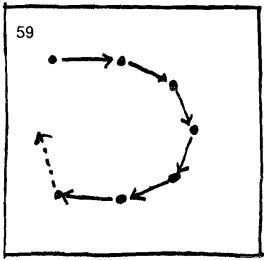 |
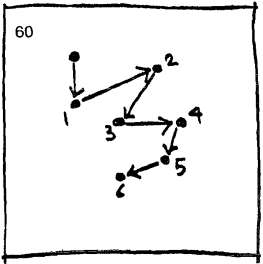 |
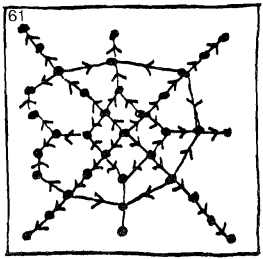 |
|||
| The influence « disappears » after it has gone through say, 6 transmissions. | In this case, 6 is the « transmission capacity » of the man in the group. | If the human « valency » and the transmission capacity, are natural limits, the size of human groups (egalitarian, hierarchical or others) also cannot exceed certain limits: hence the notion of « critical group » size. |
|||
| The influence « disappears » after it has gone through, say 6 transmissions. | In this case, 6 is the «transmission capacity » of the group in the network. | If the group « valency » and « transmission capacity » are natural limits, the size of organization networks (egalitarian, hierarchical or others) also cannot exceed certain limits: hence the notion of « critical network » size. |
|||
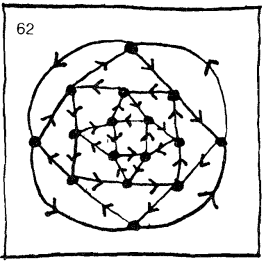 |
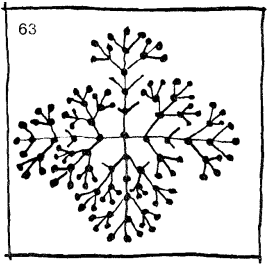 |
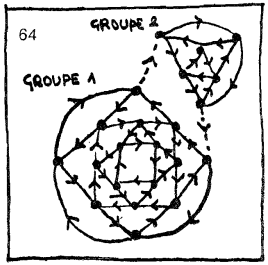 |
|||
| Here is the egalitarian critical group. (valency: 4, transmission capacity: 6). No egalitarian group composed of human beings (valency 4 transmission capacity 6) can have more than 16 members. | However, the hierarchical critical group can admit more than 900 individual members (the diagram is incomplete for lack of space). | A group which exceeds the critical group size characteristic of a desired social structure, must either 1. keep its structure and split into two groups or 2 change its structure. |
|||
| Here is the egalitarian critical network (valency 4, transmission capacity 6), No egalitarian network composed of human groups (valency 4, transmission capacity 6) can have more than 16 member groups. | However, the hierarchical critical network can admit more than 900 groups as members (the diagram is incomplete for lack of space). | A network which exceeds the critical network size characteristic of a desired social structure must either 1. keep its structure and split into two organization networks or 2. change its structure. |
|||
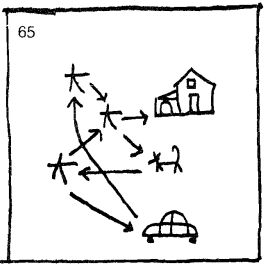 |
|
||||
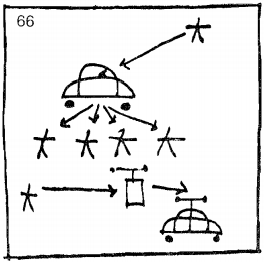 |
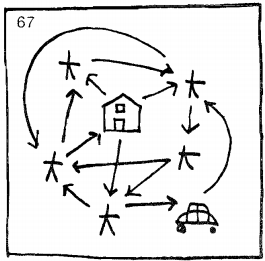 |
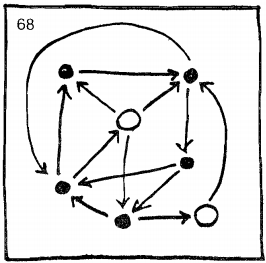 |
|||
| Objects also have their « valency » and their" transmission capacity» (because of the manner in which they are used, an automobile can only be driven by one person at a time, for example, whether by a driver or via radio). | The involvement of a number of objects in a group may modify the critical size. Because of the number of objects in their possession, the members of this group can only make use of a fraction of their valency between themselves. | If you want the group to which you belong to function according to the social structure which you prefer then be careful of the critical group size and the objects which may modify it. | |||
| Technological systems also have their « valency » and their "transmission capacity» (Because of the manner in which they are used. A transportation system can only used by a fixed maximum number of persons at one time, for example). | The involvement of technological systems in an organization network may modify the critical size. Because of the number of technological systems with which the groups interact, the members of the network can only make use of their interaction capacity among themselves. | If your group wants the organization network to which it belongs to function according to the social structure which it prefers then be careful of the critical network size and the technological system which may modify it. | |||
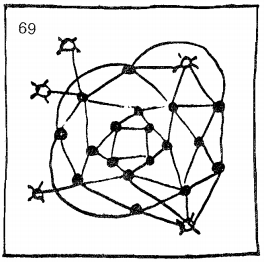 |
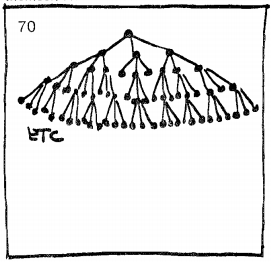 |
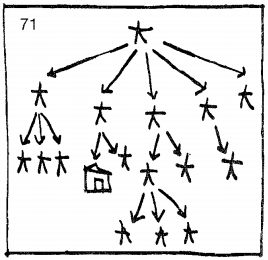 |
|||
| No-one can transform his own group into an egalitarian group if his group is too "big" (that is if it contains too many people and too many objects). | A hierachical group cannot grow without limits either. | This is the reason for the disintegration of many groups, states, towns & societies. | |||
| No group can transform its organization network into an egalitarian network if its network is too « large » (that is if it contains too many groups and too many technological systems). | A hierarchically coordinated network cannot grow without limits either. | This is the reason for the disintegration of many organization networks, states, towns and societies. | |||
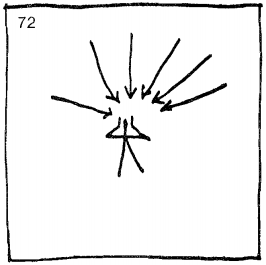 |
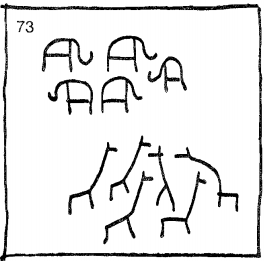 |
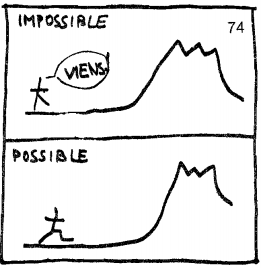 |
|||
| Exceeding the critical group size introduces a malaise. | Each animal species is characterized by its own critical group size. (Because the « valency» and the « transmission capacity» are properties of all species and can only be changed very slowly.) |
Our group life becomes much easier if we transform what may be changed and do not try to change what we cannot. | |||
| Exceeding the critical network size introduces a malaise. |
The Critical Group Size
... comment by the author of the previous article (Summary of a lecture delivered in London at the Summer Session '72 of the International Institute of Design.)
This paper concerns a till-now-unformulated social problem, which is significant enough, even for architects and planners, but which is really vital for any simple human being, like you and me. I mean the problem of the critical group.
Let us define the term, or better, let us give some preliminary explanations in order to elucidate the concept of this critical group.
I use the term society for any set of human individuals, in which there is at least one link between any individual and the rest of the set.
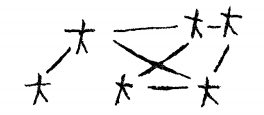
The links relating these individuals are communications taking place between them. A communication is observable only if it ends up by some influence being received by one of the individuals to whom this link is relating. The existence of such an influence is observable, because its reception involves some change in the behaviour (prior to the arrival of the influence) of the influenced individual. Thus an influence has a direction, and we will express it by an arrow which points towards the individual who receives the influence.

Thus a society wherein individuals are linked by communications (which result in observable influences), can be mapped by what the mathematician calls a directed connected graph, The structure of such a society will be thus mapped by certain structural characteristics 01 this graph.
The first such characteristic will be a parameter, which I call (as one name is as good as another) the social situation of a particular person. In order to obtain this parameter, I have to calculate the sum of all influences started by a particular person (whose social situation I want to obtain), and deduct from this sum the total of all influences he gets lrom all the other individuals belonging to the same society. Social situation will thus be the numerical balance of all influences concerning a given particular person belonging to a given society.
We have to note here, that - in practical terms - the size of an influence is not actually measurable. In order to set up such a calculation, we have to be satisfied with a count based on the simple statement of the existence (value I) or of the non-existence (value 0 of an influence between any two given persons.
I have to add another limitation to this definition: any influence which is transmitted from one individual to another through an intermediate person, loses its original intensity (whatever it was) in inverse proportion to the number of necessary transmissions.
There is no difficulty in calculating all the social situations of all the members of a given society: the social situation of any individual member will be the sum of all influences starting from him towards all the other members of this society, and from this sum there will be deducted the sum of all influences coming to him from each of the others. Once these social situation parameters are drawn up for all members of the society, the effective hierarchy within the society becomes apparent.
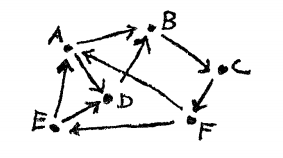
Obviously enough, if any member leaves a society, the individual balances may shift. I will call these shift values the dependencies ot all individual members upon the one leaving. The dependency function (the difference between a particular social situation calculated first before, then after the defection of a member of the society) indicates who is interested in keeping whom within a given society. It is thus possible to draw up a table of allies.
These two functions (social situation and dependency) clearly define the social structure within any group. Thus for example an egalitarian society would be any such social organization wherein all social situations belonging to all particular members would be practically the same, etc.
The types of possible social structures, once this terminology is used, would belong in the main to three large families: hierarchical society, egilitarian society and hybrid society (this last one is the most common).
The following graphs show a typical example of each of these families:

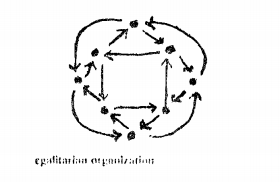
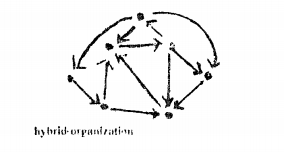
Now, as we have succeeded in defining social structure (in a very condensed way because the limited length of this paper does not allow discussion of many other aspects), we can look for a meaning for critical group.
As members of a society are human beings, they have some specific biologically determined characteristics which we have to take into consideration. The first of them is what I call valency. i.e. the largest number of communications a human being can handle during a given duration. We can illustrate valency for instance, by the example of a person who talks simultaneously on several phones: he can surely talk on two phones, perhaps on three, but surely is incapable of talking simultaneously on 12 phones.
A threshold number (for example four phones) can be defined experimentally; this threshold number shows human valency.
The second characteristic which is meaningful to our investigation is the one I call human channel capacity i.e. the characteristic error rate in message transmission. We hinted at this characteristic when we stated earlier that the intensity of a transmitted influence is less than the original one. I will express channel capacity also through a threshold number, which indicates the number of transmissions of a message through intermediate persons, at which number the original message completely loses its originai content (it disappears).
Now, particular values of these two thresholds (valency and channel capacity) are biological charactenstics of the human animal, and they have a regulating effect on possible social structures. For example, iI I assume valency as 4 and channel capacity as 6 (i.e. a human could handle not more than 4 simultaneous communications, and a communication transmitted by more than 6 human intermediaries would disappear), then an egalitarian society containing more than 18 members could not function any more, and a hierarchical society of more than 973 particular members would break down.
I am using the name critical group for the largest human group a) which has a dafined structure of whichever type:
b) wherein the number of links of each is less than the biologically defined valency;
c) wherein all communicatIon path-lengths are tess or equal to the threshold value defined by human channel capacity.
Otherwise expressed the critical group is the largest group containing individuals of one (or more) species which can still function accordIng to some predefined social structure.
This definition implies that critical groups are essentially characteristic of a species, and this is invariable unless the species suffers biological mutation. It implies as well, that any attempt by individuals to organize themselves into groups with more members than allowed of by the critical group size corresponding to a social structure those individuals intend to construct, will be unsuccessful.
When the actual social organization outgrows the critical group size, thus creating a heavy communication overload for its own members, as a result individual members show phenomena of alienation, and the social organization begins to disintegrate.
I explained the problem of critical groups here only in a shorthand version. In reality, there are many human problems linked to it, and investigation about critical group size itself did not start until now. Personalty, I consider that it is one of the most urgent topics to be investigated, and I do not believe social sciences, planning sciences, political tendencies or utopias can be meaningful until we know how many persons can agglomerate and assure for themselves a pattern of life (structure) of their own choice.
Technical note on critical group size
Description : a social group (a set of individuals of the same species wherein each individual is related by at least one link - influence - to the set), having any structure whatsoever and being composed of individuals who have certain specific characteristics in common (i.e. valency - the maximum number of topics on which an individual of this species can fix his attention simultaneously; and channel capacity - the maximum number of transmissions of a message by individuals of this species which keeps the content of the message still understandable).
Such a social group cannot grow in size without limits. We use the term critical group for the largest group which has a defined structure and which is formed by individuats of a defined species and which can still function. Thus, for example, a human egalitarian group (valency - 4, channel capacity - 6, for example) cannot include more than 18 members, whereas a human hierarchical group could contain, with the same specific valency and channel capacity, something around 900 people.
Critical group is thus a characteristic ot a species and limits the size of structured organizations this species can form.
History : intuitively the problem was noted all through history. The phenomenon of the critical group was often stated With reference to the animal world, but surprisingly enough, never formuiated strictly for human groups.
First statements; Vona Friedman About the possibility of social utopias (IEEE Congress, Mexico, 1971); Vona Friedman On models of utopias and on social ecology (Leonardo, Oxfort, 1971); Vona Friedman Society - Environment (CEA, Brussels, 1972).
Development : actual demographic growth and overdevelopment of communication media has favoured a group 'size larger than that of the critical group. The communication overload caused by this group size on the individual has provoked phenomena both of alienation and of disintegration (a tendency of these groups towards spl itting up).
Significance : a very short term disintegration of actual social mechanisms (a process which stops automatically the catastrophic growfh feared by the report of Prof Meadows for the Club of Rome).
Solutions : a society with weak communications. The only social organization where demographic growth does not result in outgrowing the numerical threshold represented by the critical group concept would be a society wherein the communication network would be a homogeneous n degree network, where n is smaller than the valency of the species, and wherein all communications having a path-length more than C' (c: channel capacity) would be conSidered as non existent.
Related problems and their summarized descriptions : The phenomenon of the critical group can have tangible consequences in the fields of the following problems:
Urban disintegration : towns are actually largely outgrowing critical group sizes and in consequence they are considered by their inhabitants as uninhabitable.
Inhabitants either leave towns for smaller communities, or they form inward-orientated communities (ghettoes) within the existing towns.Information pollution : critical group size is a function of communication ability of the human animal, who (because of his limited absorption capacity for information) cannot assimilate, individually or in groups, the information mass submitted to him. Groups develop thus an internal common information amount and become hermetically closed to any other information. Because of the arbitrary selection of information to be included in this amount and because the remainder (the unused information) becomes accessible to this group this selected information mass becomes polluted (i.e. transformed into a sort of incoherent suparstition).
Family disintegration : family groups today are under the critical minimum size. Family members prefer to belong to groups which are near to the critical maximum group size. As actual housing facilities do not admit cohabitation of such groups, the enforced cohabitation of the non-functioning family unit leads to insurmountable stress.
Brakes effect on growth : the catastrophiC deadlines resulting from the expansion functions exposed in the Meadows report will probably never be reached, because they may be preceded by a general disintegration of the actual social and economic mechanism - both of them very much over the limiting size allowed for by the critical group theory. Thus, social disintegration could be considered as a brake protecting the world from the breakdowns predicted by the report of the Club of Rome.
Decentralization : the phenomenon of the critical group increases the probability of success for organizations based on small and completely autonomous groups.
Society of weak communicallon : a theoretical consequence of the critical group theory could be a decrease in communication. The biologicai factors of the criticai group concept are based on the limited information assimilation capacity of human beings, and they imply that communications overload destroys the Individual. A society based on weak communication between individuals or groups can adapt itself better to the progressive disintegration and the succeeding re-grouping of organizations actually over critical group size.
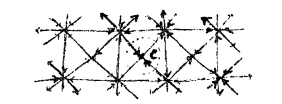
For example, if v = 8, c = 3, any person can be a (sub) - center of this society of weak communication whatever its size (in the example, C is a center).
Decrease of media : an implication of 5) and 6).
- Escape territories : a long time moderator of social disintegration was the existence of escape territories i.e. territories where nonadapted individuals or groups could emigrate. Actual lack of escape territories makes social crisis more violent. In consequence, such territories should be created either artificially (for example, desert rehabilitation, floating islands etc.) or by weakening the communication network (which can promote formation of social islands).
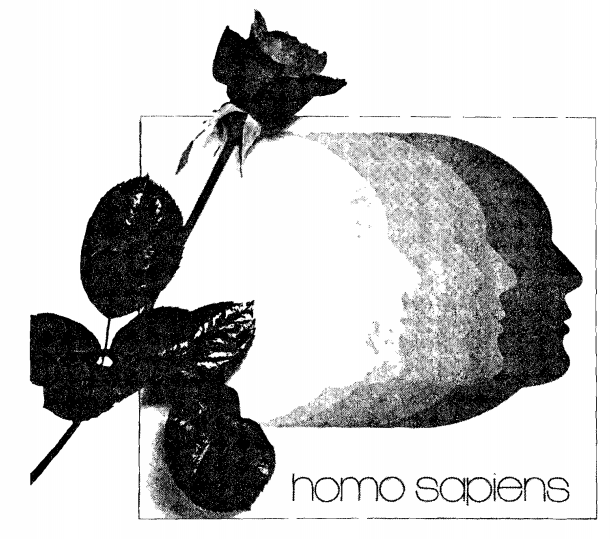
l'etat humain... la dimension oubliee
Ce n'est pas souvent que l'on rencontre un cadeau idéal pour ses amis de par le monde qui s'interessent à l'être humain, sa diversité et son besoin de liberté.
Ce petit livre est pourtant de valeur pour les adultes aussi bien que pour les enfants.
On y trouve, dans une série d'images excellentes, un nombre de rappels piquants et très amusants pour ceux d'entre nous qui sont obligés, par la nature de leur travail, de voir l'être humain à travers le medium déformant des organisations et de leurs programmes. Les images (reproduites en format réduit sur ces pages) se trouvent sur une face de chaque page, permettant ainsi de les découper pour créer éventuellement un panneau d'exposition.
Les légendes sont reprises en français, anglais, allemand, italien, espagnol et suédois.
19 x 21 cm., 28 pages.
On being human... the forgotten dimension
It is not often that one finds an ideal gift for friends around the world interested in human beings, their variety, and their need for freedom.
This little book is, however, meaningful to both children and adults. It presents, in a series of excellent full-page images, a number of gentle and very amusing reminders to those of us who are obliged by the nature of our work to see man through the distorting medium of organizations and their programmes.
The images (reproduced in a reduced format on the accompanying pages) are on one side of the page only. They could therefore be cut out to make a good display.
The brief commentaries on each image are in English, French, German, Italian, Spanish and Swedish.
19 x 21 cm, 28 pages.
Obtainable from:
Bokforlaget Corona AB,
Box 1074
5-22104 Lund, Sweden.

